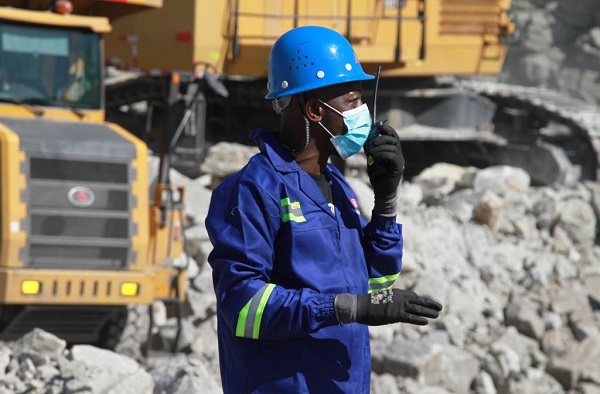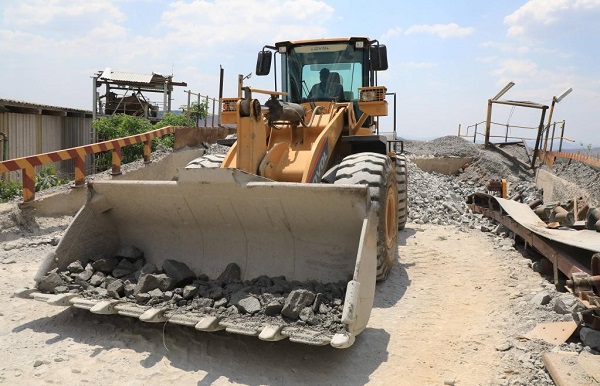Zimbabwe is witnessing an influx of Chinese investments in the mining sector, as the resource-rich southern African country seeks to increase mineral production and maximize beneficiation in order to get better returns from its vast mineral wealth.

Panashe Shayawabaya, a Chinese language interpreter, speaks through a walkie-talkie at a mining site in Hwange, Matebeleland North Province, Zimbabwe, on June 13, 2022. (Photo by Tafara Mugwara/Xinhua)
HARARE, July 2 (Xinhua) -- Zimbabwe is witnessing an influx of Chinese investments in the mining sector, as the resource-rich southern African country seeks to increase mineral production and maximize beneficiation in order to get better returns from its vast mineral wealth.
In 2019, Zimbabwe set out an ambitious drive to more than quadruple mining sector revenue by hauling minerals worth 12 billion U.S. dollars by 2023.
In 2021, the country earned about 5.7 billion dollars in mineral exports, a huge leap from 3.2 billion dollars recorded the previous year.
Chinese investments in the mining sector are expected to play a significant role in the realization of Zimbabwe's mining sector recovery and growth plans.
In the month of June alone, Zimbabwean President Emmerson Mnangagwa commissioned two major Chinese mining projects in gold and lithium mining.
On June 10, Mnangagwa commissioned a 35 million U.S. dollar gold crush and recovery plant by Radnor mine in Makaha, Mudzi district in the Mashonaland East Province.
Radnor Mining firm, is a subsidiary of ZimCN, a partnership between local and Chinese investors.
"Such investments, enhanced exploration activities, the resuscitation of closed mines, opening of new mines, expansion of existing mines, and adoption of new and more efficient mining techniques are contributing to the realization of our mining sector target of a 12 billion U.S. dollar mining sector by 2023," said Mnangagwa.
Gold is Zimbabwe's largest foreign currency earner, and the precious metal is expected to contribute 4 billion dollars towards the envisaged mining sector growth ambition.

The file photo shows a track loader driver goes about his work at Shamva Gold Mine in Mashonaland Central, Zimbabwe, Nov. 18, 2020. (Xinhua/Shaun Jusa)
A week following the commissioning of the gold plant, Mnangagwa officiated the launch of Sinomine's 200 million dollar project to build a lithium mining and processing plant in Bikita, Masvingo Province.
"My government cherishes the willingness of companies from the People's Republic of China to invest in Zimbabwe. This has led to a number of top tier Chinese conglomerates investing in various sectors of our economy, with win-win benefits for all," Mnangagwa said.
In addition, he said the investment solidifies Zimbabwe's position in the global electric car industry.
"It is my expectation that the development of the lithium mining sector in Zimbabwe will lead to growth of value chain linkages in the manufacturing industry," said Mnangagwa.
He added that given Zimbabwe's vast lithium deposits, the country is positioned to become a center of research, development and manufacturing of green energy and lithium-based solutions in the region.
The Bikita lithium deal followed China's Zhejiang Huayou Cobalt's acquisition of the Arcadia lithium mine near Harare for 422 million dollars in December last year.
"We intend to develop the project rapidly over the next year and invest around 300 million U.S. dollars to develop the mine and construct a process plant with a capacity to treat around 4.5 million tonnes of ore and produce 400,000 tonnes of lithium concentrate per annum," the company said.
Zimbabwe possesses Africa's largest lithium reserves. The country has set an ambitious target of earning 500 million dollars from lithium exports starting from next year from 2 million in 2017.
Apart from gold and diamond mining, investors from China have also shown interest in the mining of lithium, gold, chrome, diamonds, nickel, among other minerals.
China's Tsingshan Holdings Group, the world's top producer of nickel and stainless steel, is constructing an iron ore mine and a carbon steel plant in Mvuma, about 190 km from Harare.
The one billion dollar project, which upon completion will become one of the largest steel plants in the region, is expected to reinvigorate Zimbabwe as a major steel producer.
To support the government's push for local beneficiation, AfroChine, a subsidiary of Tsingshan, and one of the largest ferrochrome producers in Zimbabwe, has made notable investments in the construction of chrome smelters.
Last year Zimbabwe's value addition drive also received a major boost after Dinson Colliery Company, another subsidiary of Tsingshan, commenced coke production at its plant in Hwange, Matebeleland North Province.
Notable Chinese investments have also been recorded in black granite mining and processing, coal mining, processing and power generation, nickel, among others.
ABOUT CHINA MINING
CHINA MINING CONFERENCE AND EXHIBITION (CHINA MINING) IS OFFICIALLY SUPPORTED BY MINISTRY OF NATURAL RESOURCES CHINA. SINCE FIRST HELD IN 1999, CHINA MINING HAS BECOME ONE OF THE WORLD’S TOP MINING EVENTS AND ONE OF THE WORLD’S LARGEST MINING EXPLORATION, DEVELOPMENT AND TRADING PLATFORMS, COVERING ALL ASPECTS OF THE WHOLE MINING INDUSTRY CHAIN, INCLUDING SURVEY AND EVALUATION, EXPLORATION AND MINING, TECHNIQUES AND EQUIPMENT, INVESTMENT AND FINANCE, TRADE AND SERVICES, ETC., PLAYING AN ACTIVE PROMOTION ROLE IN CREATING EXCHANGE OPPORTUNITIES AND ENHANCING MUTUAL COOPERATION BETWEEN DOMESTIC AND FOREIGN MINING ENTERPRISES.
With the theme of "Multilateral cooperation—for development and prosperity of post pandemic era", China Mining Conference and Exhibition 2021 (CHINA MINING 2021) was held in Tianjin China on October 21-23, 2021. For more information about CHINA MINING, please visit: www.chinaminingtj.org/en/.



